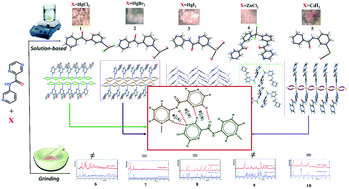Hydrogen bond synthons affect the coordination geometry of d10-metal halide complexes: synthetic methods, theoretical studies, and supramolecular architectures†
Abstract
In this study, five new d10-metal halide coordination compounds, namely, [HgCl2(L)]n (1), [HgBr2(L)]n (2), [HgI2(L)]n (3), [ZnCl2(L)2] (4), and [CdI2(L)2]n (5) (L is N-(3-pyridinyl)-2-pyrazine carboxamide ligand) have been prepared by solution-based methods and structurally characterized. The green synthesis of these coordination compounds containing L ligand in solvent-free conditions have also been reported. X-ray single crystal diffraction analysis of these compounds reveals that all complexes have polymeric structures while 4 is a discrete compound. Compounds 1 and 2 form one-dimensional chains along the a-axis, 3 forms 1D zig-zag chain extending in the b-direction, 4 forms discrete molecules, and self-assembly in 5 creates 1-D polymeric chains extending along the c-axis. In the mercury complexes, for halogen replacement from the chloride to bromide anion, no structural change was observed but replacement with iodide resulted in significant changes in the architecture of compound 3. The effect of an additional coordination site in pyrazine in comparison with the pyridine ring in our previously reported complexes was explored as an effective factor in coordination geometry and the final crystal structure of these new compounds. The results indicated that a common feature in the crystal structures of these compounds is the participation of the NH and CO of the amide group and the pyrazine nitrogen atoms to form R22(8) and R12(6) motifs of NH⋯N and CH⋯O hydrogen bonds, which affected the coordination geometry and structural assembly. Furthermore, the theoretical investigation of the different conformers observed in the titled compounds were also performed. To explore the reactivity of the starting materials in the solid state, neat and liquid-assisted grinding and thermal methods were utilized. The PXRD patterns of the resulting compounds reveal that although the same product can be obtained, in some cases, different products were isolated in solvent-free conditions.

- This article is part of the themed collection: Supramolecular & Polymorphism


 Please wait while we load your content...
Please wait while we load your content...